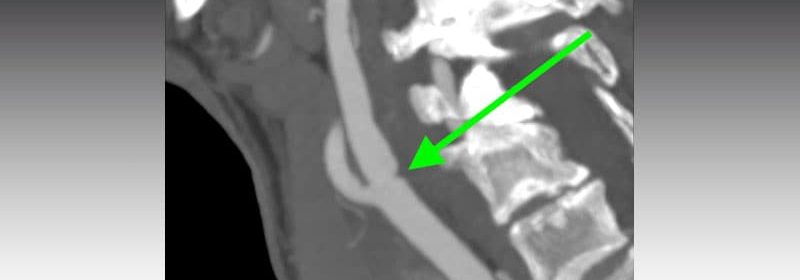Recurrent Stroke ‘Alarmingly High’ With Carotid Web

Among patients who have ischemic stroke and are found to have a carotid web ― a protrusion in the carotid artery ― rates of recurrent stroke are unacceptably high. Such patients may need more intensive secondary prevention measures, a new study suggests.
In the study, investigators analyzed data from a broad cohort of patients with large-vessel occlusion strokes and found that the rate of recurrent stroke was 17% over 2 years.
Dr Jonathan Coutinho
“Patients with a carotid web had a five times increased risk of recurrent stroke than those without a carotid web and eight times the risk of an ipsilateral stroke. These are alarmingly high rates,” senior author Jonathan M. Coutinho, MD, Amsterdam University Medical Center, Amsterdam, the Netherlands, told Medscape Medical News.
“The vast majority of these patients had not been previously identified to have a carotid web and were just being managed with routine antiplatelet therapy. I think our results show that this is insufficient, and these patients probably need to be managed differently,” he said.
Coutinho is calling for an international registry to study these patients more closely and to investigate more intensive treatments, which could include anticoagulants or surgery/stenting.
The study was published online in JAMA Neurology on May 10.
The authors explain that a carotid web is a shelflike lesion located along the posterior wall of the internal carotid artery bulb. It is thought to be a variant of fibromuscular dysplasia or an embryonal remnant.
Because the carotid web protrudes into the lumen of the carotid artery, it can disrupt flow, and blood stasis can occur, resulting in thrombus formation and subsequent ischemic stroke.
Case-control studies have found that carotid webs are present in 9% to 37% of patients younger than 60 years who have cryptogenic stroke and may occur more frequently among women and Black persons.
Although it is known that carotid web increases the risk for recurrent stroke, the actual rate of recurrent stroke in these patients is unknown, because so far, the only data have come from case reports and uncontrolled, retrospective, single-center studies that were limited by publication and selection bias.
The current study examined the recurrent stroke rate in 3439 consecutive patients with large-vessel occlusion stroke in the Netherlands who were enrolled in the MR CLEAN randomized trial and the following MR CLEAN registry. The researchers point out that because the inclusion criteria of both these studies were broad, the findings of the current study are widely generalizable to other patients with large-vessel occlusion stroke.
Two neuroradiologists reevaluated CT-angiography images for the presence or absence of carotid web and identified 30 patients with carotid web ipsilateral to the index stroke.
For these 30 patients, detailed follow-up data regarding stroke recurrence within 2 years were acquired and were compared with data from 168 patients without carotid web who participated in the MR CLEAN extended follow-up trial.
The median age of the whole cohort of 3439 patients was 72 years, and 53% were men. Patients with carotid web were younger (median age, 57 years); 73% were women.
The carotid webs were located in the right internal carotid artery in 24 of the 30 patients (80%). Two patients had a bilateral carotid web.
Three patients with an ipsilateral carotid web had had an ischemic stroke prior to the index stroke, two of which were in the same vascular territory as the carotid web. In 24 of 30 patients (80%) with an ipsilateral carotid web, no other cause for the index stroke was found. For six patients (20%), the stroke may have had a cardioembolic cause (atrial fibrillation).
The vast majority (28 of the 30) patients with carotid web received medical management after the index stroke: 23 with antiplatelet therapy, and five with anticoagulant therapy.
During 2 years of follow-up, 5 of the 30 patients with carotid web (17%) had a recurrent stroke, compared with 3% of those without carotid web (adjusted hazard ratio, 4.9).
One patient with carotid web underwent carotid endarterectomy 19 days after the index stroke. One patient who received antiplatelet therapy had a recurrent ischemic stroke 6 months after the index stroke and underwent carotid endarterectomy 8 days thereafter. Both patients remained free of stroke after carotid endarterectomy. None of the patients with carotid web underwent carotid stenting.
Type and location of the recurrent stroke could be ascertained in 4 of 5 patients with carotid web. These four recurrences were all ischemic strokes in the same vascular territory as the carotid web.
The risk for recurrent ischemic stroke was increased eightfold in patients with a carotid web ipsilateral to the index stroke, as compared to patients without a carotid web. None of the six patients with a carotid web contralateral to the index stroke had a recurrent stroke.
Coutinho noted that a major question that was not addressed in this study is how to treat these patients who are found to have a carotid web.
“The unacceptably high recurrent stroke risk we observed indicates that standard medical management alone may not provide sufficient protection,” he said.
He pointed out that two options could be explored: (1) more intensive medical therapy with the use of anticoagulants, which makes pathophysiologic sense because of the pattern of blood flow that occurs in carotid web; and (2) treating the web itself with surgery or stenting.
“Endovascular stenting may be a better secondary stroke prevention strategy, particularly in patients already receiving endovascular treatment for LVO [large-vessel occlusion], but further study is warranted,” the authors write. “Carotid surgery may also be an option, although such an invasive strategy should be deliberated with caution,” they add.
“We need data on these different approaches,” Coutinho stressed.
Although a randomized trial would be ideal, such a trial is unlikely because the condition is so rare. A large international registry of consecutive patients to record the recurrent stroke risk with different treatments is probably the way forward, he believes.
Coutinho noted that carotid web is a cause of stroke that has been underappreciated.
“We urge clinicians to look more closely for carotid web in patients who have had a stroke with no other cause, particularly in younger patients. It can easily be identified on thin-slice CT angiography when you know what you are looking for. Then these patients need to be followed up more closely,” he said.
The study received funding only from nonprofit organizations. The MR CLEAN trial and registry were funded by the Erasmus University Medical Center, the Amsterdam University Medical Centers, and the Maastricht University Medical Center, the Dutch Heart Foundation and the Applied Scientific Institute for Neuromodulation. Coutinho has received grants (institutional) from Boehringer Ingelheim, Bayer, and Medtronic to fund research outside the submitted work.
JAMA Neurol. Published online May 10, 2021. Abstract
For more Medscape Neurology news, join us on Facebook and Twitter.
Source: Read Full Article
